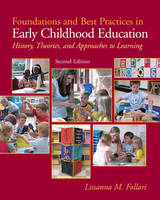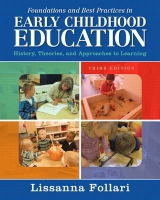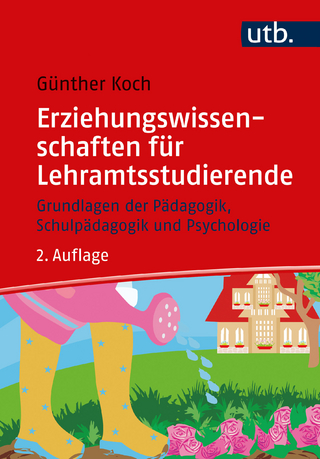
Foundations and Best Practices in Early Childhood Education
Pearson (Verlag)
978-0-13-703446-8 (ISBN)
- Titel erscheint in neuer Auflage
- Artikel merken
• Complete Assignments and Activities to apply text content to real classroom situations.
• Authentic classroom video shows real teachers and students interacting, and helps prepare you for the classroom.
• Explore the Building Teaching Skills and Dispositions exercises to practice and strengthen the skills that are essential to teaching.
• Case studies offer real-life perspectives on common issues and challenges faced in the classroom.
• Authentic student and teacher classroom artifacts provide you with the actual types of materials encountered every day by teachers.
To order this book WITH MyEducationLab, use either ISBN:
ISBN-13: 9780131381155
ISBN-10: 0131381156
Part I Foundations
CHAPTER 1 Introduction to the Field of Early Childhood Education
Your Role as a Teacher-Education Student
Roles of the Early Childhood Professional
Current Issues Facing Early Childhood Professionals
Beginning the Journey
SUMMARY
Application Activities
Websites
CHAPTER 2 Historical Overview: People and Beliefs That Shaped the Field
Historical Trends
Life in the 1600s: Harsh Traditions and New Ideas
Classroom View
Education in the 1700s: Romantic and Radical
Classroom View
Education in the 1800s: Kindergarten Is Born
Care or Education and the Separation of Early and Elementary Education
Moving Education Forward in the 1900s: Progressive and Developmental
Classroom ViewP
The Rise of Child Study
The Progressive Era Dawns
Modern Movements and Trends
Today’s Issues
Conclusion
Reflection Questions: Looking Back and Looking Ahead
Summary
Application Activities
CHAPTER 3 Professionalism in Early Childhood Education: Defining Best Practices
Classroom View
New section- Defining Professionalism: The role of associations
National Association for the Education of Young Children: NAEYC at Work
Foundation and Scope of NAEYC: promoting best practices
The DAP Framework: Theory and Practice
The Code of Ethical Conduct: History and Principles
Meaningful Applications: Using DAP and the Code
Conclusion
Reflection Questions: Looking Back and Looking Ahead
Summary
Application Activities
CHAPTER 4 Constructivist Learning: Building Knowledge From Within
Classroom View
What Is Constructivism All About? The Big Picture
Here and Now: Contemporary Constructivist Beliefs
Piaget’s Contributions to Constructivism
Vygotsky’s Contributions to Constructivism
Beyond Piaget: Social Learning, Language, and Culture
Criticisms and Challenges of Translating Theory Into Practice
Strategies for Applying Constructivist Theory to Early Childhood Education
How constructivist teachers support family culture and diversity
Conclusion
Reflection Questions: Looking Back and Looking Ahead
Summary
Application Activities
CHAPTER 5 Multiple Intelligences Theory: Applications in the Early Childhood Classroom
Classroom View
Overview of Gardner’s Work
Intelligence and Creative Thinking
Defining Intelligence
The Eight Multiple Intelligences: Many Kinds of Smart
Self-Reflection: Developing Our Intrapersonal Strength
Rethinking Education: A New Vision of Active Learning
Roles of the Teacher
Assessment
Applying Multiple Intelligences in Early Childhood Education: Personalization and Diversity
Conclusion
Reflection Questions: Looking Back and Looking Ahead
Summary
Application Activities
Part II Models and Approaches
CHAPTER 6 Head Start and Early Head Start: Empowering Change From Within
Classroom View
Historical Perspective: The Start of Early Intervention
The Need for Social Renewal: Defining Characteristics
Head Start Program Standards
Does It Work? Evidence of Effectiveness
Current Trends and Implications
Applying Head Start principles in any practice
Conclusion
Reflection Questions: Looking Back and Looking Ahead
Summary
Application Activities
CHAPTER 7 The High/Scope Foundation: Planning, Implementing, and Reviewing Best Practices
Classroom View
Overview of High/Scope
Educational Programming
Teacher Roles
Assessment
Inclusion and Cultural Responsiveness
Research
Considerations and Applications
Conclusion
Reflection Questions: Looking Back and Looking Ahead
Summary
Application Activities
CHAPTER 8 The Project Approach: Active Inquiry in Early Childhood
Classroom View
Overview of the Project Approach
Explanation of the Parts and Process: How It All Fits Together
How Project Work Fits Into Current Beliefs About Good Practice
Applications With Young Children
Conclusion
Reflection Questions: Looking Back and Looking Ahead
Summary
Application Activities
CHAPTER 9 The Schools of Reggio Emilia: A Child’s World
Overview of the Reggio Emilia Philosophy
Classroom View
The Schools of Reggio Emilia, Italy: History, Influences, and Relationships
Challenges to Reggio-Inspired Practice in America: Lost in the Translation?
The Reggio Emilia Approach and diversity
Inspired Applications: How Some American Educators Are Making the Leap
Conclusion
Reflection Questions: Looking Back and Looking Ahead
Summary
Application Activities
CHAPTER 10 Montessori Education: Environment, Materials, and Methods
Classroom View
Who Was Maria Montessori? Auspicious Beginning and Lasting Legacy
Basic Principles of the Montessori Method
Teachers’ Roles and Functions
Montessori Materials and Activities
Reflections, Controversies, and Accolade
Supporting diversity and family involvement
Applying Montessori principles and practices
Reflection Questions: Looking Back and Looking Ahead
Summary
Application Activities
CHAPTER 11 Waldorf Education: Harmony and the Whole Child
Classroom View
The History and Philosophy of Waldorf Education
View of Child Development
Waldorf Early Childhood Programs
Early Childhood Teachers’ Roles
Curriculum
Diversity and Inclusion in Waldorf Education
Contemporary Issues: Debates about Waldorf Education
Inspirations for application from Waldorf practices
Conclusion
Reflection Questions: Looking Back and Looking Ahead
Summary
Application Activities
Part III Beginning the Journey
CHAPTER 12 Bringing It All Together: Imagining and Becoming
Guiding Principles for the Future: Respect, Enthusiasm, Commitment
Re-emphasize diversity, inclusion, play, standards, applying `best of the best’
Culminating the Text and Creating Your Portfolio
Conclusion
Application Activities
Appendix A: Historical Time Line Char
Appendix B: Key Contributors Chart
Appendix C: Guiding Principles Chart
Appendix D: Multiple Intelligence Planning Web
Appendix E: Sample Professional Portfolio Rubric
Appendix F: “Look What’s Developing” Chart
References
Index
| Erscheint lt. Verlag | 10.2.2010 |
|---|---|
| Sprache | englisch |
| Maße | 204 x 256 mm |
| Gewicht | 660 g |
| Themenwelt | Sozialwissenschaften ► Pädagogik ► Allgemeines / Lexika |
| Sozialwissenschaften ► Pädagogik ► Vorschulpädagogik | |
| ISBN-10 | 0-13-703446-6 / 0137034466 |
| ISBN-13 | 978-0-13-703446-8 / 9780137034468 |
| Zustand | Neuware |
| Haben Sie eine Frage zum Produkt? |
aus dem Bereich



